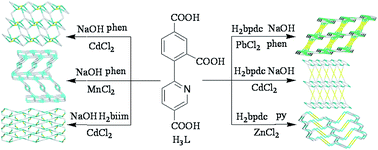A series of mixed-ligand 2D and 3D coordination polymers assembled from a novel multifunctional pyridine-tricarboxylate building block: hydrothermal syntheses, structural and topological diversity, and magnetic and luminescent properties†
Abstract
A series of novel mixed-ligand coordination polymers, namely, {[Cd2(μ4-L)(μ3-OH)(phen)2]·2H2O}n (1), {[Mn3(μ5-L)2(phen)2(H2O)]·H2O}n (2), [Cd2(μ3-L)(H2biim)2(μ2-Hbiim)]n (3), {[Pb2(μ4-L)(μ4-bpdc)0.5(phen)2]·H2O}n (4), [Cd2(μ5-L)(μ2-bpdc)0.5(phen)2]n (5), and [Zn2(μ4-L)(μ2-bpdc)0.5(py)2]n (6), was hydrothermally synthesized using 4-(5-carboxypyridin-2-yl)isophthalic acid (H3L) as a new and virtually unexplored multifunctional pyridine-tricarboxylate building block, along with various auxiliary ligands {phen = 1,10-phenanthroline, H2biim = 2,2′-biimidazole, H2bpdc = 4,4′-biphenyldicarboxylic acid, and py = pyridine}. All the products 1–6 were characterized by IR spectroscopy, elemental, thermogravimetric, and single-crystal X-ray diffraction analyses. Compounds 1, 3, and 5 reveal 2D metal–organic layers with the kgd, fes, and 3,4,5L5 topology, respectively, whereas the metal–organic frameworks (MOFs) 2, 4, and 6 disclose 3D underlying nets with the unique (2, 4) or ins (6) topology. The results indicate that the nature of the metal(II) ion and type of auxiliary ligand play a significant role in determining the dimensionality, topology and other structural features of the obtained products. Luminescent (for 1 and 3–6) and magnetic (for 2) properties were studied and discussed.


 Please wait while we load your content...
Please wait while we load your content...